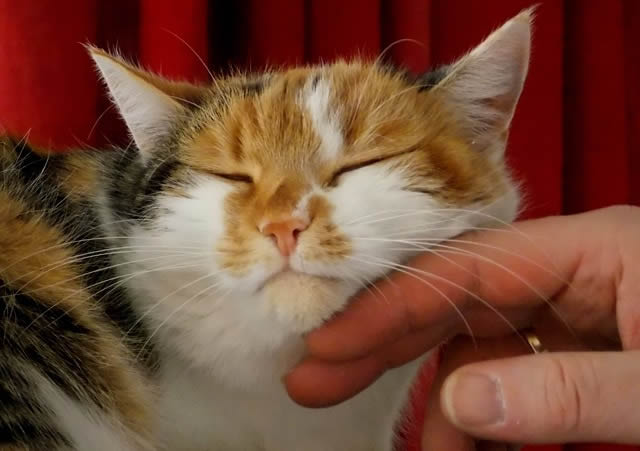今日から「The complicated truth about a cat’s purr -「猫のゴロゴロにまつわる複雑な真実」を読んでいます。

We think we know what a cat’s purr means.
私たちは、猫が喉を鳴らす意味を知っているつもりだ。
It is arguably the most recognisable sign of animal contentment:
それは動物が満足感を示す最もわかりやすいサインとされ、
a pleasurable rasp that erupts whenever a cat is tickled or petted, the soundtrack to countless sessions sprawled on an owner’s lap.
猫がくすぐられたり、撫でられたりしたときに発する快い鳴き声で、飼い主の膝で寝そべる猫がよく奏でる音楽だ。
rasp「(石目)やすり、やすりをかける音、ギリギリいう音」。
erupt「爆発・噴火・噴出する、どっと出る、突発する、爆発させる、吹き出る、発疹する、生え出る」。
But that’s not quite the full story.
だがそれが全てではない。
There is a lot more going on with the cat’s purr than you might reasonably expect.
猫の喉鳴らし音には、想像以上のことが隠されている。
Even the ‘how’ was long a subject of debate.
「どうやって喉を鳴らすのか」という点ですら、長い間議論の対象であった。
Some thought it was linked to blood flowing to the inferior vena cava, a vein that carries deoxygenated blood to the right side of the heart.
脱酸素状態の血液を心臓の右側に運ぶ、下大静脈に流れる血液と関連するという意見もあった。
inferior「(位置・階級が)下位・下級の、低い、(質・程度などが)劣った、下等・劣等の」。
vena cava「大静脈」。
But with more research it seemed likelier that the noise came from the muscles within the cat’s larynx.
しかし研究が進むにつれ、それは猫の喉頭の筋肉から出る音ではないかと考えられるようになった。
larynx「喉頭」。
As they move, they dilate and constrict the glottis – the part of the larynx that surrounds the vocal chords -
動きに合わせて、声帯を取り囲む喉頭部の声門を拡張、収縮させ、
dilate「広げる、拡張する、ふくらませる」。
constrict「締めつける、圧縮する、収縮させる、抑制・制限する」。
glottis「声門」。
and the air vibrates every time the cat breathes in or out.
猫が息を吸ったり吐いたりするたびに空気が振動する。
The result? A purr.
その結果が、あのゴロゴロ音だ。
確かあのゴロゴロ音には、体の傷んだ細胞を修復する効果があるとか。
もしそうなら、猫が喜んであの音を鳴らす機会が多いほど、猫の健康にも良いんじゃないか?
だから出来るだけ可愛がって、たくさんゴロゴロさせたい、それが一番の健康法かなと思って心がけてます(笑)。
理由は単純明快!「少ないコストでしっかり楽しく学べるから」。
私自身の経験(高機能でビックリ)をびっしり書いていますので、良かったら読んでみてください。
下のバナーからどうぞ!






